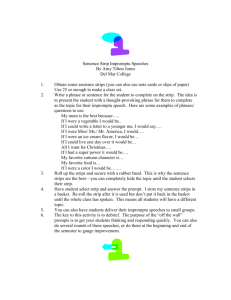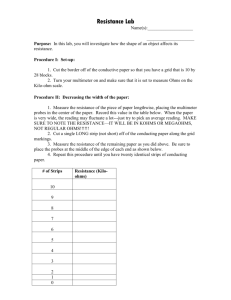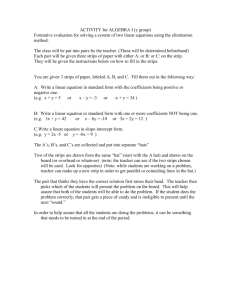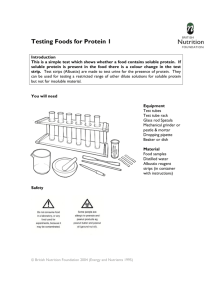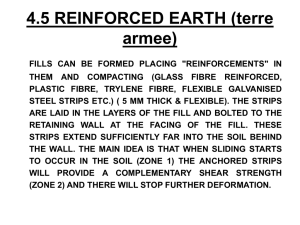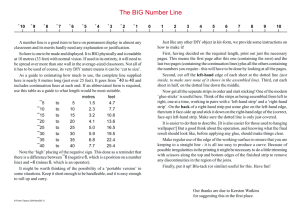Transformations of Border Strips and Schur Function Determinants
advertisement
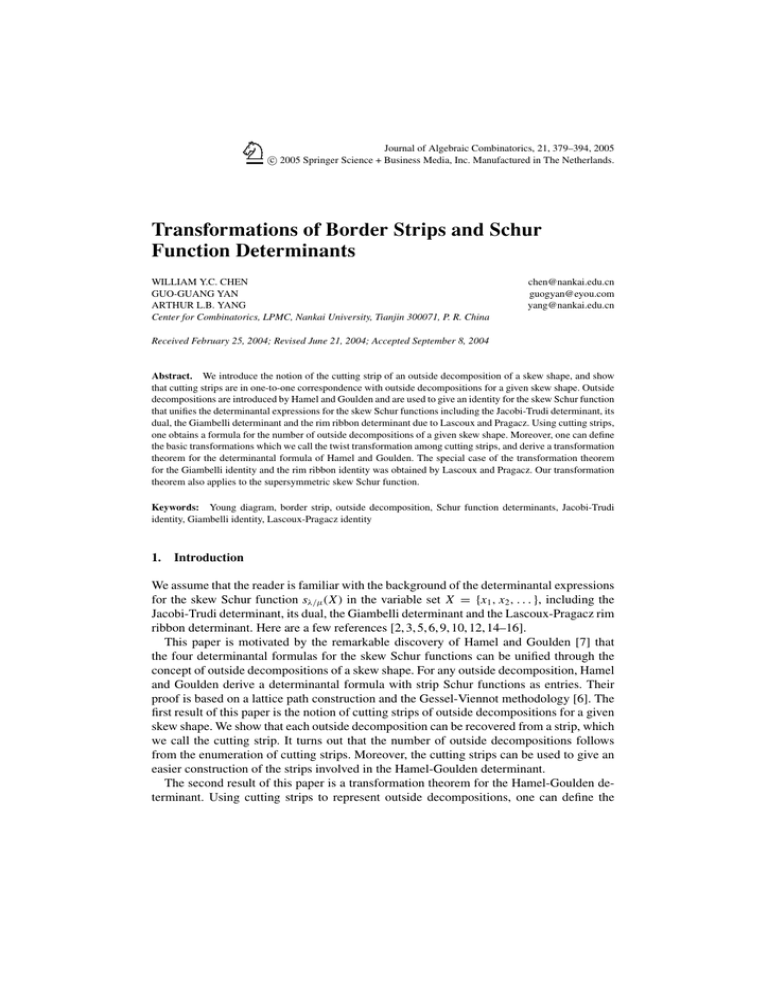
Journal of Algebraic Combinatorics, 21, 379–394, 2005
c 2005 Springer Science + Business Media, Inc. Manufactured in The Netherlands.
Transformations of Border Strips and Schur
Function Determinants
WILLIAM Y.C. CHEN
GUO-GUANG YAN
ARTHUR L.B. YANG
Center for Combinatorics, LPMC, Nankai University, Tianjin 300071, P. R. China
chen@nankai.edu.cn
guogyan@eyou.com
yang@nankai.edu.cn
Received February 25, 2004; Revised June 21, 2004; Accepted September 8, 2004
Abstract. We introduce the notion of the cutting strip of an outside decomposition of a skew shape, and show
that cutting strips are in one-to-one correspondence with outside decompositions for a given skew shape. Outside
decompositions are introduced by Hamel and Goulden and are used to give an identity for the skew Schur function
that unifies the determinantal expressions for the skew Schur functions including the Jacobi-Trudi determinant, its
dual, the Giambelli determinant and the rim ribbon determinant due to Lascoux and Pragacz. Using cutting strips,
one obtains a formula for the number of outside decompositions of a given skew shape. Moreover, one can define
the basic transformations which we call the twist transformation among cutting strips, and derive a transformation
theorem for the determinantal formula of Hamel and Goulden. The special case of the transformation theorem
for the Giambelli identity and the rim ribbon identity was obtained by Lascoux and Pragacz. Our transformation
theorem also applies to the supersymmetric skew Schur function.
Keywords: Young diagram, border strip, outside decomposition, Schur function determinants, Jacobi-Trudi
identity, Giambelli identity, Lascoux-Pragacz identity
1.
Introduction
We assume that the reader is familiar with the background of the determinantal expressions
for the skew Schur function sλ/µ (X ) in the variable set X = {x1 , x2 , . . . }, including the
Jacobi-Trudi determinant, its dual, the Giambelli determinant and the Lascoux-Pragacz rim
ribbon determinant. Here are a few references [2, 3, 5, 6, 9, 10, 12, 14–16].
This paper is motivated by the remarkable discovery of Hamel and Goulden [7] that
the four determinantal formulas for the skew Schur functions can be unified through the
concept of outside decompositions of a skew shape. For any outside decomposition, Hamel
and Goulden derive a determinantal formula with strip Schur functions as entries. Their
proof is based on a lattice path construction and the Gessel-Viennot methodology [6]. The
first result of this paper is the notion of cutting strips of outside decompositions for a given
skew shape. We show that each outside decomposition can be recovered from a strip, which
we call the cutting strip. It turns out that the number of outside decompositions follows
from the enumeration of cutting strips. Moreover, the cutting strips can be used to give an
easier construction of the strips involved in the Hamel-Goulden determinant.
The second result of this paper is a transformation theorem for the Hamel-Goulden determinant. Using cutting strips to represent outside decompositions, one can define the
380
CHEN, YAN AND YANG
basic steps to transform any outside decomposition to another which we call the twist
transformations. For the twist transformations on outside decompositions, we give a construction of determinantal operations that transform the determinantal formula for one
outside decomposition to the determinantal formula corresponding to any other outside
decomposition.
We remark that the arguments in this paper can be carried over to the case of supersymmetric skew Schur functions and the corresponding determinantal formulas.
2.
Cutting strips
We begin this section with a review of relevant terminology and notation. Let λ be a partition
of n with at most k parts, i.e., λ = (λ1 , λ2 , . . . , λk ) where λ1 ≥ λ2 ≥ · · · ≥ λk ≥ 0 and
λ1 + λ2 + · · · + λk = n. The (Young or Ferrers) diagram of λ may be defined as the set of
points (i, j) ∈ Z2 such that 1 ≤ j ≤ λi and 1 ≤ i ≤ k. It can be represented in the plane
by an array of square boxes or cells that is top and left justified with k rows and λi boxes
in row i. A box (i, j) in the diagram is the box in row i from the top and column j from
the left. Given two partitions λ, µ with at most k parts, and λi ≥ µi , for i = 1, 2, . . . , k,
then λ/µ is a skew partition, and the diagram of skew shape λ/µ or the skew diagram of
λ/µ is defined as the set of points (i, j) ∈ Z2 such that µi < j ≤ λi and 1 ≤ i ≤ k. In this
paper, we will not distinguish a skew partition λ/µ with its diagram. Thus, the conjugate
of a skew partition λ/µ, which we denote by λ /µ , is defined to be the transpose of the
skew diagram λ/µ.
A (border) strip or a ribbon is a skew diagram with an edgewise connected set of boxes
that contains no 2 × 2 block of boxes, where two boxes are said to be edgewise connected if
they share a common edge. One may impose a natural direction to each strip. The starting
box is always the one at the lower left corner. Moreover, for each box that is not the last box in
a strip, we say that it goes right if the next box is to its right, otherwise, we say that it goes up.
Recall that the content of a box (i, j) in a skew diagram λ/µ is given by j − i, and a
diagonal with content c of λ/µ is the set of all the boxes in λ/µ having content c.
Let λ/µ be a skew diagram, a border strip decomposition of λ/µ is a partitioning of
the boxes of λ/µ into pairwise disjoint strips. Figure 1 gives two examples of border strip
decompositions of the skew shape 6653/211. We now come to the crucial definition of an
outside decomposition of a skew shape as introduced by Hamel and Goulden [7]. A border
strip decomposition of λ/µ is said to be an outside decomposition of λ/µ if every strip in
the decomposition has a starting box on the left or bottom perimeter of the diagram and an
ending box on the right or top perimeter of the diagram, see figure 1.
Figure 1.
Border strip decompositions.
BORDER STRIPS
381
We note that there is slight difference between our description of the outside decomposition and the original definition given by Hamel and Goulden. Since the positions of the
strips in an outside decomposition are distinguishable, we may impose a canonical order on
the strips. However, in the original treatment of Hamel and Goulden an order of the strips
is taken into account and they have noted that any order plays the same role. As we will
see later in this paper, we may use the canonical order of the strips by the contents of the
ending boxes.
Given an outside decomposition of a skew diagram λ/µ, and a box (i, j) in λ/µ, then
there is a strip θ in that contains (i, j), and we say that the box (i, j) goes right or goes
up in λ/µ if it goes right or goes up in θ. When (i, j) is the ending box of θ , then it is on
the top or the right perimeter of λ/µ, and we say that (i, j) goes up in λ/µ if it is on the top
perimeter of λ/µ (including the case when it is a corner of λ/µ), and (i, j) goes right in
λ/µ if it is on the right perimeter of λ/µ. The directions of the boxes are important owing
to the following nested property.
Nested Property (Hamel and Goulden [7]) The strips in any outside decomposition of
λ/µ are nested in the sense that the boxes in the same diagonal of λ/µ all go up or all go
right.
An immediate consequence of the above nested property is that the contents of the ending
(or starting) boxes of the strips in an outside decomposition are different. Hence we may
use the contents of the ending boxes to order the strips in an outside decomposition. If
there are m strips in , we will denote by = (θ1 , θ2 , . . . , θm ), where θ1 is the strip
whose ending box has the largest content, etc. In this notation, the outside decomposition
of 6653/221 given in figure 1(b) may be denoted by (4221/11,21,3322/211).
Let λ/µ be a skew diagram. Recall that a block of λ/µ of a skew shape is an edgewise connected component. If a skew shape λ/µ can be decomposed into k blocks B1 , B2 , . . . , Bk ,
then an outside decomposition of λ/µ can be decomposed into 1 , 2 , . . . , k , where
each i is an outside decomposition of Bi , i = 1, 2, . . . , k. Therefore, without loss of
generality one can only deal with outside decompositions of edgewise connected skew
shapes. In the same vein, skew Schur function with disconnected shapes can be expressed
as a product of skew Schur functions with connected shapes.
Based on the nested property, we are now ready to give construction of the cutting strip
of an outside decomposition of an edgewise connected skew shape λ/µ.
Definition 2.1 Let be an outside decomposition of an edgewise connected skew shape
λ/µ. Suppoese that λ/µ has d diagonals. The cutting strip T of is given by the rule: for
i = 1, 2, . . . , d − 1, the i-th box in T goes right or goes up according to whether the boxes
in the i-th diagonal of λ/µ go right or go up with respect to .
Conversely, for any border strip with d boxes, we may reconstruct the outside decomposition by peeling off λ/µ while sliding the cutting strip along the diagonals. This operation
can be visualized by figure 2.
Thus, we obtain the following correspondence.
382
Figure 2.
CHEN, YAN AND YANG
The cutting strip of an outside decomposition.
Theorem 2.2 If λ/µ is an edgewise connected skew shape with d diagonals, then there is
a one-to-one correspondence between the outside decompositions of λ/µ and border strips
with d boxes.
The above correspondence leads to the following formula for the number of outside
decompositions of an edgewise connected skew shape.
Corollary 2.3 Let λ/µ be an edgewise connected skew shape with d diagonals. Then λ/µ
has 2d−1 outside decompositions.
The determinantal formula of Hamel and Goulden relies on the operation # on border
strips of an outside decomposition. We will show that the # operation can be described in
terms of the cutting strip of the outside decomposition. To this end, we need to record the
contents of the diagonals in the construction of the cutting strip. For example, the cutting
strip in figure 3 inherits the contents of the boxes in the original shape.
Given an outside decomposition of a skew shape λ/µ and a strip θ in , let φ be the
cutting strip of . We denote the content of the starting box of θ and the content of the
Figure 3.
Contents of a cutting strip.
383
BORDER STRIPS
ending box of θ respectively by p(θ ) and q(θ), then θ forms a segment of the cutting strip
of starting with the box having content p(θ ) and ending with the box with content q(θ ),
which is denoted by φ[ p(θ), q(θ)], or simply [ p(θ ), q(θ )] if no confusion arises. Note that
the contents of the cutting strip are inherited from the contents in the original skew shape.
Furthermore, we may extend the notation φ[ p, q] by the following convention:
(1) if p ≤ q, then φ[ p, q] is a segment of φ starting with the box having content p and
ending with the box having content q;
(2) φ[q + 1, q] = ∅;
(3) if p > q + 1, then φ[ p, q] is undefined.
The difference between an empty strip and an undefined strip lies in values of the corresponding Schur functions. For an empty strip, the corresponding Schur function is defined
to be 1, and for the undefined strip, the Schur function takes the value 0. Next we observe
that the # operation on strips can be described as extracting segments of the cutting strip.
The proof of the following fact is omitted since it is merely a technical verification.
Theorem 2.4 Let λ/µ be an edgewise connected skew shape, and be an outside decomposition of λ/µ. For any strips θi , θ j in , the strip θi #θ j , as defined in [7], can be
represented as [ p(θ j ), q(θi )].
For example, the strips in figure 3 are θ1 = 33/2, θ2 = 2, θ3 = 21, θ4 = 22/1, θ5 = 1,
θ6 = 3, and some of the strips obtained by the # operation are given below (see figure 4):
3.
θ1 #θ5 = [−2, 5] = 5511/4,
θ2 #θ3 = [−1, 2] = 31,
θ5 #θ1 = [2, −2] = undefined,
θ4 #θ6 = [−5, −1] = 44/3,
θ6 #θ4 = [−3, −3] = 1.
θ3 #θ2 = [1, 1] = 1,
Transformations of determinants
This section is concerned with a transformation theorem on the determinantal formula
of Hamel and Goulden [7]. In the proof of the rim ribbon formula for Schur functions,
Lascoux and Pragacz give a transformation from the Giambelli determinant to the rim
Figure 4.
θ1 #θ5 as a segment [−2, 5] of the cutting strip.
384
CHEN, YAN AND YANG
ribbon determinant. Since the Hamel-Goulden determinant is a unification of the four
known determinantal identities, it is natural to consider the transformation on the HamelGoulden determinants, namely, from one outside decomposition to another. From the cutting
strip characterization of outside decompositions, it follows that one can obtain any outside
decomposition from another by a sequence of basic transformations of changing the directions of the boxes on a diagonal, which corresponds to the operation of changing the
direction of a box in the cutting strip. This transformation is called the twist transformation on border strips. Specifically, we use ωi to denote the twist transformation acting
on an outside decomposition by changing the directions of the diagonal boxes with
content i.
We may restrict our attention to the determinantal transformations that correspond to the
twist transformations on the cutting strips, or equivalently on the outside decompositions.
Let us review the Hamel-Goulden determinantal formula. Without loss of generality, we
may assume that λ/µ is an edgewise connected skew shape with d diagonals. Let =
(θ1 , θ2 , . . . , θm ) be an outside decomposition of λ/µ. Then we have
Theorem 3.1 (Hamel and Goulden [7])
by the following determinant:
sθ1 #θ1
s
θ2 #θ1
D() = det
..
.
sθm #θ1
The skew Schur function sλ/µ (X ) can be evaluated
sθ1 #θ2
...
sθ2 #θ2
..
.
...
...
sθ2 #θm
.. ,
.
sθm #θ2
...
sθm #θm
sθ1 #θm
(3.1)
where s∅ = 1 and sθi #θ j = 0 if θi #θ j is undefined.
We recall that the above determinantal formula includes the Jacobi-Trudi identity, the
dual Jacobli-Trudi identity (the Nägelsbach-Kostka identity), the Giambelli identity and
the rim ribbon identity as special cases. Note that for any order of the strips in the outside
decomposition, the above determinant remains invariant. The corresponding cutting strips
for the above special cases are the horizontal strip, the vertical strip, the maximal hook, and
the maximal outside rim ribbon, see [7]. As noticed by Lascoux and Pragacz [9], one may
obtain the rim ribbon identity from the Giambelli identity, and vice versa. We may expect
that the above mentioned four identities can be transformed from one to another. In fact,
this goal can be achieved in a more general setting in terms of the transformation theorem
on the Hamel-Goulden identity.
For an outside decomposition = (θ1 , θ2 , . . . , θm ) of λ/µ, we define its inversion
number by
inv() = |{(i, j); p(θi ) > p(θ j ), q(θi ) < q(θ j )}|.
385
BORDER STRIPS
By the cutting strip characterization of the # operation, we may rewrite (3.1) as
s[ p 1 , q 1 ]
s
[ p1 , q 2 ]
(−1)inv() det
..
.
s[ p1 , qm ]
s[ p 2 , q 1 ]
s[ p 2 , q 2 ]
..
.
...
s[ p m , q 1 ]
s[ p m , q 2 ]
.. ,
.
s[ p 2 , q m ]
...
s[ p m , q m ]
...
...
(3.2)
where p1 > p2 > · · · > pm are the rearrangement of p(θ1 ), . . . , p(θm ) in decreasing
order and qi = q(θi ) for 1 ≤ i ≤ m. Since p1 > p2 > · · · > pm and q1 > q2 > · · · >
qm , it is clear that if s[ pi ,q j ] = 0 then s[ pi , q j ] = 0 and s[ pi , q j ] = 0 for j ≤ j ≤ m
and 1 ≤ i ≤ i. The above canonical form is more convenient for the construction of
the determinantal transformations corresponding to the twist transformations on outside
decompositions.
Now the question becomes how to transform the determinant (3.2) for an outside decomposition to the determinant corresponding to the outside decomposition ωi (). To
accomplish this goal, we need an important product rule for the skew Schur functions due
to Zelevinsky [17], which follows from the Jeu de Taquin of Schützenberger [13], and can
be verified by the combinatorial definition. This product rule is also used by Lascoux and
Pragacz [9] in their transformation from the Giambelli identity to the rim ribbon identity.
Given two skew diagrams I and J , I J is the diagram obtained by gluing the lower
left-hand corner box of diagram J to the right of the upper right-hand corner box of diagram
I and I ↑ J is the diagram obtained by gluing the lower left-hand corner box of diagram J
to the top of the upper right-hand corner box of diagram I . For example, if I = 32/1 and
J = 332/2, then I J and I ↑ J are given by figure 5.
Lemma 3.2 Let I and J be two skew diagrams. Then
s I s J = s I J + s I ↑J .
As far as this paper is concerned, we will only need the above property for ribbon Schur
functions, or the strip Schur functions. More specifically, we need to multiply a row of
the Hamel-Goulden determinant by a ribbon Schur function and subtract the product from
another row to obtain a new ribbon Schur function.
Figure 5.
The and ↑ operator for skew diagrams.
386
CHEN, YAN AND YANG
For two strips α and β, one has two ways to combine them into another ribbon, one is
α β and the other is α ↑ β. It turns out that the basic transformation on the cutting strip
is an interchange of the operations α β and α ↑ β. This is the reason why we call ωi the
twist transformation.
Theorem 3.3 If λ/µ is an edgewise connected skew shape with d diagonals, let be an
outside decomposition of λ/µ, then for each diagonal of λ/µ with content i, we can obtain
D(ωi ()) from D() by elementary determinantal operations.
We remark that the elementary determinantal operations mentioned in the above theorem
actually involve three types, i.e., interchanging two rows or columns; multiplying a row or a
column by a non-zero scalar, or adding a multiple of one row or one column to another row
or column; and from two determinants, one can construct a bigger determinant by forming
a bigger diagonal block matrix, or one can reduce a diagonal determinant into two smaller
determinants, one of which may be the identity matrix.
Note that if L is a diagonal of an edgewise connected skew diagram λ/µ, then there are
four possible diagonal types classified by whether the first diagonal box has a box on the
top, and whether the last diagonal box has a box on the right. These four types are depicted
by figure 6.
We now proceed to give the proof of Theorem 3.3. There are essentially two different types
(Type 1 and Type 3), because Type 2 is similar to Type 1, and Type 4 is similar to Type 3.
For Type 1 and Type 2 diagonals, the determinantal transformations involve changing a
determinant to another determinant of different order. We need the following lemma for
counting the number of inversions of a sequence of pairs of numbers, which will be used
to deal with the sign change of determinants after permuting rows and columns. Given
a sequence of m pairs P = {(a1 , b1 ), (a2 , b2 ), . . . , (am , bm )} with a1 , a2 , . . . , am being
distinct and b1 , b2 , . . . , bm being distinct. We define the inversion number of the sequence by
inv(P) = |{(i, j); ai > a j , bi < b j }|.
Figure 6.
Four possible types of diagonals of λ/µ.
387
BORDER STRIPS
It can be easily seen that the inversion number depends only on the set of pairs in a sequence.
We choose the sequence notation for the sake of presentation.
Lemma 3.4 Let P = {(a1 , b1 ), (a2 , b2 ), . . . , (am , bm )} be a sequence of m pairs such
that a1 , a2 , . . . , am are distinct and b1 , b2 , . . . , bm are distinct. Let σ be a permutation of
1, 2, . . . , m acting on the indices of a1 , a2 , . . . , am , σ (ai ) = aσ (i) , then we have
inv({(σ (a1 ), b1 ), (σ (a2 ), b2 ), . . . , (σ (am ), bm )}) ≡ inv(σ ) + inv(P) (mod 2).
Proof: Suppose bi1 < bi2 < · · · < bim is the reordering of b1 , b2 , . . . , bm , then we have
inv(P) = inv ai1 , ai2 , . . . , aim = (k, l); aik > ail , k < l .
and
inv({(σ (a1 ), b1 ), (σ (a2 ), b2 ), . . . , (σ (am ), bm )})
= inv aσ (i1 ) , aσ (i2 ) , . . . , aσ (im )
≡ inv(σ ) + inv((ai1 , ai2 , . . . , ain )) (mod 2)
≡ inv(σ ) + inv(P) (mod 2).
This completes the proof.
We are now ready to present the proof of Theorem 3.3 for Type 1 diagonals. Let =
(θ1 , θ2 , . . . , θm ) be an outside decomposition of an edgewise connected skew diagram λ/µ,
and let φ be the cutting strip of . Recall that the sequence of the contents of the starting
boxes of the strips in is p1 > p2 > · · · > pm and the sequence of the contents of the
ending boxes of the strips in is q1 > q2 > · · · > qm .
Suppose that λ/µ has a Type 1 diagonal L with content i, and suppose that there are r
boxes in L. We may assume without loss of generality that the diagonal boxes all go up,
since we may reverse the transformation process for the case that the diagonal boxes all go
right. Thus the cutting strip of may be written as [ pm , i] ↑ [i + 1, q1 ] and the cutting
strip of ωi () may be written as [ pm , i] [i + 1, q1 ]. Notice that the twist transformation
ωi does not change the contents of the cutting strip of .
Since ωi only changes the strips which contain a box in L, we may suppose that θit ,
1 ≤ t ≤ r , is the strip in that contains the t-th diagonal box in L. Then we have
p(θit ) ≤ i < q(θit ), for 1 ≤ t ≤ r . As illustrated in figure 7, under the operation ωi , the
strip
θi1 = p θi1 , q θi1 = p θi1 , i ↑ i + 1, q θi1
breaks into two strips
p θi1 , q θi2 = p θi1 , i i + 1, q θi2
and
i + 1, q θi1 .
388
CHEN, YAN AND YANG
Figure 7.
ωi acts on a Type 1 diagonal L.
If r > 1 then the last strip
θir = p θir , q θir = p θir , i ↑ i + 1, q θir
will be cut off into [ p(θir ), i], and the other strips
θit = p θit , q θit = p θit , i ↑ i + 1, q θit , 2 ≤ t ≤ r − 1,
will be twisted into
p θit , q θit+1 = p θit , i i + 1, q θit+1 .
By Lemma 3.4 one can verify that inv(ωi ()) ≡ inv() (mod 2).
Since p(θit ) < i + 1 for 1 ≤ t ≤ r , there is a unique integer k, 1 ≤ k ≤ m − r + 1, such
that pk < i + 1 and pk−1 > i + 1 where p0 is defined to be ∞, if necessary. Therefore,
there are exactly k − 1 strips in for which the contents of starting boxes are bigger
than i + 1, and there are exactly k − 1 + r strips in for which the contents of ending
boxes are bigger than i. It follows that qk+r −1 > i and qk+r < i if k + r < m + 1.
Moreover, the sequence of the contents of the starting boxes of the strips in ωi () becomes
p1 > · · · > pk−1 > i + 1 > pk > · · · > pm , and the sequence of the contents of the ending
boxes of the strips in ωi () becomes q1 > · · · > qk+r −1 > i > qk+r > · · · > qm . As noted
before, the determinant D() has the following canonical form:
(−1)inv() det
A
0
B
,
C
(3.3)
389
BORDER STRIPS
where
s[ p1 , q1 ]
...
s[ pk−1 , q1 ]
..
..
A=
,
.
...
.
s[ p1 , qk+r −1 ] . . . s[ pk−1 , qk+r −1 ] (k+r −1)×(k−1)
s[ pk , i]↑[i+1, q1 ]
...
s[ pm , i]↑[i+1, q1 ]
..
..
B=
,
.
.
.
.
.
s[ pk , i]↑[i+1, qk+r −1 ] . . . s[ pm , i]↑[i+1, qk+r −1 ] (k+r −1)×(m−k+1)
s[ pk , qk+r ] . . . s[ pm , qk+r ]
..
..
C=
.
.
...
.
s[ pk , qm ] . . . s[ pm , qm ] (m−k−r +1)×(m−k+1)
Using the sequences of the contents of starting boxes and ending boxes of the strips of
ωi (), we may obtain the following canonical form of D(ωi ()):
A
inv(ωi ())
(−1)
det 0 . . . 0
0
s[i+1, q1 ]
..
.
s[i+1, qk+r −1 ]
1
0
..
.
. . . s[ pm , i]
,
C
B
s[ pk , i]
(3.4)
0
where
s[ pk , i][i+1, q1 ]
..
B =
.
s[ pk , i][i+1, qk+r −1 ]
...
...
...
s[ pm , i][i+1, q1 ]
..
.
s[ pm , i][i+1, qk+r −1 ]
.
(k+r −1)×(m−k+1)
Now we need to transform (3.3) into the following determinant by adding a row and a
column as shown below. This operation involves a sign (−1)2k+r :
0
..
A
B
.
0
0 ... 0 1 s
inv()
[ pk , i] . . . s[ pm , i]
(−1)
det
(3.5)
0
..
0
C
.
0
390
CHEN, YAN AND YANG
Applying Lemma 3.2, we have
s[ pt , i][i+1, ql ] = s[ pt , i] s[i+1, ql ] − s[ pt , i]↑[i+1, ql ]
for k ≤ t ≤ m and 1 ≤ l ≤ k + r −1. The above identity enables us to use the (k +r )-th row
of (3.5) to twist the entries in B by elementary determinantal operations. Such operations
will change B into −B . Multiplying the last m − k + 2 columns and the last m − k − r + 2
rows of (3.5) by −1, we may derive (3.4) from (3.5). It follows that we can transform
D() into D(ωi ()) by elementary determinantal operations. This completes the proof of
Theorem 3.3 for Type 1 diagonals.
We next consider the case when λ/µ has a Type 3 diagonal L with content i. Suppose
that there are r boxes in L and suppose that the directions of the diagonal boxes of L all
go up. Thus, the cutting strip of may be written as [ pm , i] ↑ [i + 1, q1 ] and the cutting
strip of ωi () may be written as [ pm , i] [i + 1, q1 ]. We assume that θit , 1 ≤ t ≤ r , is the
strip in that contains the t-th diagonal box in L. Then we have p(θit ) ≤ i ≤ q(θit ), for
1 ≤ t ≤ r . As illustrated in figure 8, under the operation ωi , the first strip θi1 = [ p(θi1 ), i]
equals
p θi1 , q θi2 = p θi1 , i i + 1, q θi2 .
If r > 1, the last strip
θir = p θir , q θir = p θir , i ↑ i + 1, q θir
will be cut off into [ p(θir ), i], and the other strips
θit = p θit , q θit = p θit , i ↑ i + 1, q θit ,
will be twisted into
p θit , q θit+1 = p θit , i i + 1, q θit+1 , 2 ≤ t ≤ r − 1.
By Lemma 3.4 one may verify that inv(ωi ()) ≡ inv() + r − 1 (mod 2).
Figure 8.
ωi acts on a Type 3 diagonal L.
391
BORDER STRIPS
Since i is the content of the ending box of θi1 and q(θit ) ≥ i for 1 ≤ t ≤ r , there is a
unique integer k, 1 ≤ k ≤ m − r + 1 such that qk = i. So we have pk−r +1 < i + 1 and
pk+r > i + 1 if k + r < m + 1. Note that in this case D() still has the canonical form
(−1)inv() det
E
F
0
G
,
(3.6)
where
s[ pk−r , q1 ]
..
.
s[ pk−r , qk−1 ]
...
s[ p1 , q1 ]
..
.
E=
s[ p1 , qk−1 ]
...
...
...
0
0
s[ pk−r +1 , i]↑[i+1, q1 ]
..
.
F =
s[ pk−r +1 , i]↑[i+1, qk−1 ]
...
...
...
...
s[ pk−r +1 , i]
s[ pk−r +1 , qk+1 ] . . .
..
G=
.
...
s[ pk−r +1 , qm ] . . .
,
k×(k−r )
s[ pm , i]↑[i+1, q1 )]
..
.
s[ pm , i]↑[i+1, qk−1 ]
s[ pm , i]
,
k×(m−k+r )
s[ pm , qk+1 ]
..
.
.
s[ pm , qm ] (m−k)×(m−k+r )
On the other hand, D(ωi ()) has the following canonical form:
(−1)inv(ωi ()) det
E
0
F
G
(3.7)
where
s[ pk−r +1 , i][i+1, q1 ]
..
.
F =
s[ pk−r +1 , i][i+1, qk−1 ]
s[ pk−r +1 , i]
...
...
...
...
s[ pm , i][i+1, q1 )]
..
.
s[ pm , i][i+1, qk−1 ]
s[ pm , i]
.
k×(m−k+r )
Applying Lemma 3.2 we get
s[ pt , i][i+1, ql ] = s[ pt , i] s[i+1, ql ] − s[ pt , i]↑[i+1, ql ]
for k − r + 1 ≤ t ≤ m and 1 ≤ l ≤ k − 1. So, we may change F into −F . Furthermore, by
changing the signs of rows and columns, we obtain (3.7) from (3.6) with a sign (−1)r +1 . It
392
CHEN, YAN AND YANG
follows that we can transform D() into D(ωi ()) by elementary determinantal operations.
Note that in this case there is no change on the order of the determinants.
The other two types of diagonals can be dealt with in a similar way. Hence we have
completed the proof of Theorem 3.3.
For example, let λ = 5331, and let 1 , 2 , 3 , 4 be the outside decompositions of
λ with respect to the Jacobi-Trudi determinant, the Giambelli determinant, the LascouxPragacz determinant and the dual Jacobi-Trudi determinant. Then we have the following
relations:
ω−1 ω−2 ω−3 (1 ) = 2 ,
ω1 ω0 ω−1 ω−2 (2 ) = 3 ,
ω3 ω2 ω−1 ω−2 (3 ) = 4 .
So we may transform the Jacobi-Trudi determinant for s5331 into the Giambelli determinant
for s5331 , and transform the Giambelli determinant into the Lascoux-Pragacz determinant,
and transform the Lascoux-Pragacz determinant to the dual Jacobi-Trudi
determinant.
h 5
h
2
h 1
0
h6
h3
h7
h4
h2
h3
0
1
h8
h 5 ω−3
→
h4
h 1
ω−2
→
ω1
→
ω−1
→
ω3
→
s5
s2
s1
s6
s3
s2
s71 ω−2
s41 →
s31 s5
s2
s1
s611
s311
s211
s6 ω−1
s3 →
s2 s5111
s2111
s1111
s51
s21
s11
s5 s2 s1 s51 s621/1 s5 s52/1 s631/2 s41 ω s5 s6 s71 −1 ω0 s21 s321/1 s2 → s2 s3 s41 → s22/1 s331/2 s11 s11 s221/1 s1 s1 s2 s31 s2
s31
s1 s5331/22 s422/11 s311 ω s422/11 s42211/11 s311 −2 s22/1
s11 → s22/1
s2211/1
s11 s331/2
s31
s2
s2
s1 s211
s1 s2 s2111 s21111 s2111111 s311 s3111 s311111 ω2 1 s111 s1111 s111111 s11 s111 s11111 → 0 s11
s111
s11111 s1
s11
s1111
0
s1
s11
s1111 e1 e2 e5 e6 e8 1 e 1 e4 e5 e7 0 1 e 3 e4 e6 0 0 e 2 e3 e5 0 0 e 1 e2 e4 BORDER STRIPS
4.
393
Supersymmetric Schur functions
We note that Lemma 3.2 also holds for the supersymmetric Schur function sλ/µ = sλ/µ (X, Y )
with variable set in the form X = {. . . , x−1 , x0 , x1 , . . . } and Y = {. . . , y−1 , y0 , y1 , . . . }.
This fact can be verified by the tableaux representation of sλ/µ (X, Y ) given in [4] and
the symmetric property of sλ/µ (X, Y ) in X and Y . From the Jacobi-Trudi identity for the
super Schur function sλ/µ (X, Y ) given in Goulden-Greene [4], and Macdonald [11], one
can derive a determinantal formula analogous to Hamel and Goulden’s identity for supersymmetric Schur functions. The lattice path interpretations can also be carried over to the
supersymmetric case by using the weights given by Chen-Yan-Yang [1] in their study of
the super Giambelli identity and the super Lascoux-Pragacz identity in the framework of
the lattice path methodology. Formally speaking, we have the following theorem.
Theorem 4.1 For any outside decomposition of a skew shape λ/µ, let D() be the
determinant in the form of (3.1) with the ribbon Schur function entries replaced by the
supersymmetric ribbon Schur functions in the variable sets X = {. . . , x−1 , x0 , x1 , . . . }
and Y = {. . . , y−1 , y0 , y1 , . . . }. Then D() equals the supersymmetric Schur function
sλ/µ (X, Y ).
Acknowledgments
We would like to thank Professor Alain Lascoux for valuable comments. This work was
done under the auspices of the 973 Project on Mathematical Mechanization, the Ministry
of Science and Technology, and the National Science Foundation of China.
References
1. W.Y.C. Chen, G.-G. Yan and A.L.B. Yang, “The skew Schubert polynomials,” Europ. J. Combin. 25 (2004),
1181–1196.
2. Ö.N. Eǧecioǧlu and J.B. Remmel, “A combinatorial proof of the Giambelli identity for Schur functions,” Adv.
Math. 70 (1988), 59–86.
3. M. Fulmek and C. Krattenthaler, “Lattice path proofs for determinantal formulas for symplectic and orthogonal
characters,” J. Combin. Theory. Ser. A 77 (1997), 3–50.
4. I.P. Goulden and C. Greene, “A new tableau representation for supersymmetric Schur functions,” J. Alg. 170
(1994), 687–703.
5. I.M. Gessel and G. Viennot, “Binomial determinants, paths, and hook length formulae,” Adv. Math. 58 (1985),
300–321.
6. I.M. Gessel and G. Viennot, “Determinants, paths, and plane partitions,” preprint.
7. A.M. Hamel and I.P. Goulden, “Planar decompositions of tableaux and Schur function determinants,” Europ.
J. Combin. 16 (1995), 461–477.
8. A. Lascoux and P. Pragacz, “Équerres et fonctuons de Schur,” C. R. Acad. Sci. Paris, Ser. I. Math. 299 (1984),
955–958.
9. A. Lascoux and P. Pragacz, “Ribbon Schur functions,” Europ. J. Combin. 9 (1988), 561–574.
10. I.G. Macdonald, Symmetric Functions and Hall Polynomials, 2nd edition, Oxford University Press, Oxford,
1995.
11. I.G. Macdonald, Schur Functions: Theme and variations, Actes 28e Séminaire Lotharingien, Publ. I.R.M.A.
Strasbourg, 1992, pp. 5–39.
394
CHEN, YAN AND YANG
12. B.E. Sagan, The Symmetric Group, 2nd edition, Springer-Verlag Press, 2001.
13. M.P. Schützenberger, La correspondance de Robinson, in Combinatorics et représentation du groupe
symmétrique (Table Ronde, Strasbourg 1976, D. Foata, ed.), Lecture Notes in Math., vol. 579, Springer,
1977, pp. 59–113.
14. R.P. Stanley, Enumerative Combinatorics, Vol. II, Cambridge University Press, 1999.
15. J.R. Stembridge, “Nonintersecting paths, Pfaffians, and plane partitions,” Adv. Math. 83 (1990), 96–131.
16. K. Ueno, “Lattice path proof of the ribbon determinant formula for Schur functions,” Nagoya Math. J. 124
(1991), 55–59.
17. A. Zelevinsky, “A generalization of the Littlewood-Richardson rule,” J. Algebra 69 (1981), 82–94.
